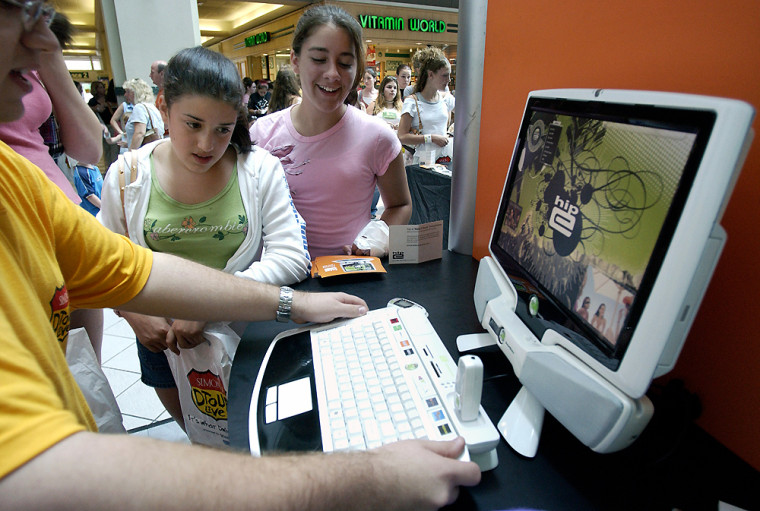This isn't your typical, humdrum, slate-colored computer. Not only is the PC known as the hip-e almost all white, but its screen and keyboard are framed in fuzzy pink fur. Or a leopard skin design. Or a graffiti-themed pattern.
Sure, it's outlandish, but you won't see the hip-e in an office cubicle. The creators of the $1,699 hip-e claim it's the first PC specifically for teenagers.
Of course, teens are infamously fickle, and today's media-savvy kids are skilled at sniffing out and rejecting things that seem contrived. Today's teens also grew up with computers and have sophisticated demands for them.
But the company behind the hip-e, Digital Lifestyles Group Inc. of Austin, Texas, believes it's got exactly what teenage computer users want.
Why such confidence? Because the company asked.
Last year, Digital Lifestyles' CEO Kent Savage got his son Cameron, 16, and seven of the boy's friends together and polled them about how they interacted with computers and the Internet.
One brand name that resonated was Apple Computer Inc., which has struck gold with its iPod music players and iTunes download service. But the teens said their parents resisted buying Apple computers because they don't run Windows, the platform most people are familiar with.
So Savage decided to "Apple-ize the PC industry."
Cameron and his friends were asked to draw up designs for their ideal PC. Two weeks later, the company came back with 20 product concepts, and in a five-hour session, the teens honed in on one.
Later the prototype went to focus groups nationwide, and now the hip-e is ready for release in November. Orders are being taken now, including at displays in malls where pop star Ashlee Simpson is performing.
"Computers were originally made for adults, for work purposes," said one member of the original design group, Nevin Watkins, 16. "I kind of really want a computer for me."
Digital hub
The hip-e is designed to serve as a hub for all of a teenager's digital interactions. (For an extra $100 it will also come with an MP3 player/keychain data-storage drive, or a cell phone that runs on Sprint's network and can be synched with data on the computer. Or both accouterments can be had for $200.)
The computer has a 120-gigabyte hard drive -- perfect for storing a huge digital music library -- plus Wi-Fi accessibility, a TV tuner and connections for video game consoles. Speakers attached to the bottom of the hip-e's display stand can be removed and turned into a portable "beatbox."
The computer has standard elements: a 1.5-gigahertz Pentium processor, Windows XP, antivirus software, spyware and pop-up blockers and parental controls. But it's been retooled to speak to teens in everyday terms.
For instance, users can click on "paper" to launch Microsoft Word, "create a presentation" to launch PowerPoint, or "burn CD" to open a CD-copying program.
The 17-inch desktop display -- which boots up to screaming black and white swirls and squiggles against a lime-green backdrop -- has a "hangout tuner," an on-screen dial that lets users jump to categories of desktop applications: music, movies, games, photos, news, communications, shopping and homework.
Savage said teenagers generally don't like performing separate searches for various programs, so "it made sense to organize it for them and serve it up to them."
"I think what Apple did with iTunes and the iPod is great. But that's just one application," he said. "We are doing that -- on steroids. It's all of these applications, all on one platform."
Tough market to reach
Bigger computing companies have had mixed success in reaching teenagers. Last year, Microsoft Corp. released free software called 3 Degrees that is designed to give groups of young people a centralized way of sharing pictures, songs and instant messages. Microsoft says it still considers 3 Degrees a pilot test and won't comment on how much use it gets.
Leading PC seller Dell Inc. has avoided age-group-specific marketing, opting instead to highlight ways anyone might use the company's machines, spokesman Venancio Figueroa said. For example, Dell advertises its portable music player in music magazines and touts portable computers in back-to-school circulars, but neither device is retooled differently for younger users.
That's why Savage figures the teen-focused hip-e has a nice niche.
He cites market research that says teens are considered the tech gurus in today's families and dictate electronics purchases.
Meanwhile, teenagers are increasingly using credit card-like debit accounts and becoming more sophisticated consumers, said Paul Soltoff, head of SendTec Inc., a marketing services firm. In fact, the hip-e includes a prepaid debit account that teens or their parents can put money into, to fund the cell phone, online shopping or music downloads.
"In certain respects, it's easier to sell to teenagers today. They're gaining more fiscal control over expenditures," Soltoff said. "They have needs and wants, too. And they recognize bargains."
Soltoff thinks the hip-e must get big-time "viral marketing" -- word-of-mouth recommendations among teens themselves.
Savage has that covered, too: Hip-e's marketing plan includes dispatching 1,000 teens as a "launch squad," whose members earn sales commissions.
Ultimately, however, the most important thing will be the hip-e's performance, said Rob Callender, senior trends manager at market tracker Teenage Research Unlimited.
That's because while teenagers love things that are designed for them, they also like to look ahead a few years, Callender said. So if the hip-e is geared for 16-year-olds, it might actually appeal to kids closer to 14.
"Teens aren't willing," he said, "to make compromises in electronics."
